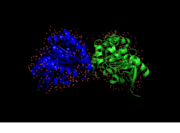User:SarahZimmerman/Sandbox 1
From Proteopedia
(Difference between revisions)
| Line 19: | Line 19: | ||
== '''Clinical Relevance''' == | == '''Clinical Relevance''' == | ||
| - | Because the cell wall envelope of M. tuberculosis is essential for the virus’ viability and virulence, it is | + | Because the cell wall envelope of M. tuberculosis is essential for the virus’ viability and virulence, it is the primary target for antimycobacterial drugs. Comprised within the cell wall is mycolic acid, a fatty acid which exists as the free glycolipids trehalose monomycolate (TMM) and trehalose dimycolate (TDM) (Gobec, 2004). |
It is known that the ag85 complex with its three protein components (A, B, and C) plays a key role in cell wall biosynthesis and the transfer of mycolic acid from one molecule of TMM to another. The resultant molecule, TDM, has been suggested to be important in maintaining M. tuberculosis cell wall integrity. Studies have also suggested that removal of ag85C from a strain of M. tuberculosis results in a significant decrease in the presence of cell-wall linked mycolic acids. Thus, scientists hypothesize that inhibition of ag85C and its mycolyltransferase activity will disrupt TDM and its ability to maintain cell wall integrity (Gobec et al, 2004). | It is known that the ag85 complex with its three protein components (A, B, and C) plays a key role in cell wall biosynthesis and the transfer of mycolic acid from one molecule of TMM to another. The resultant molecule, TDM, has been suggested to be important in maintaining M. tuberculosis cell wall integrity. Studies have also suggested that removal of ag85C from a strain of M. tuberculosis results in a significant decrease in the presence of cell-wall linked mycolic acids. Thus, scientists hypothesize that inhibition of ag85C and its mycolyltransferase activity will disrupt TDM and its ability to maintain cell wall integrity (Gobec et al, 2004). | ||
Knowing this, researchers have suggested that inhibition of mycolic acid transfer and, ultimately, ag85C, must be involved in the continuously-developing class of antimycobacterial drugs aimed at combatting M. tuberculosis (Belisle et al, 1997). | Knowing this, researchers have suggested that inhibition of mycolic acid transfer and, ultimately, ag85C, must be involved in the continuously-developing class of antimycobacterial drugs aimed at combatting M. tuberculosis (Belisle et al, 1997). | ||
Revision as of 12:18, 31 March 2015
|
Contents |
ag85C of Mycobacterium tuberculosis
SarahZimmerman/Sandbox 1. Click above on edit this page to modify. Be careful with the < and > signs. You may include any references to papers as in: the use of JSmol in Proteopedia [1] or to the article describing Jmol [2] to the rescue.
Introduction
Structure
Catalytic Triad
Active Site
Cysteine 209
Clinical Relevance
Because the cell wall envelope of M. tuberculosis is essential for the virus’ viability and virulence, it is the primary target for antimycobacterial drugs. Comprised within the cell wall is mycolic acid, a fatty acid which exists as the free glycolipids trehalose monomycolate (TMM) and trehalose dimycolate (TDM) (Gobec, 2004). It is known that the ag85 complex with its three protein components (A, B, and C) plays a key role in cell wall biosynthesis and the transfer of mycolic acid from one molecule of TMM to another. The resultant molecule, TDM, has been suggested to be important in maintaining M. tuberculosis cell wall integrity. Studies have also suggested that removal of ag85C from a strain of M. tuberculosis results in a significant decrease in the presence of cell-wall linked mycolic acids. Thus, scientists hypothesize that inhibition of ag85C and its mycolyltransferase activity will disrupt TDM and its ability to maintain cell wall integrity (Gobec et al, 2004). Knowing this, researchers have suggested that inhibition of mycolic acid transfer and, ultimately, ag85C, must be involved in the continuously-developing class of antimycobacterial drugs aimed at combatting M. tuberculosis (Belisle et al, 1997).
</StructureSection>
References
- ↑ Hanson, R. M., Prilusky, J., Renjian, Z., Nakane, T. and Sussman, J. L. (2013), JSmol and the Next-Generation Web-Based Representation of 3D Molecular Structure as Applied to Proteopedia. Isr. J. Chem., 53:207-216. doi:http://dx.doi.org/10.1002/ijch.201300024
- ↑ Herraez A. Biomolecules in the computer: Jmol to the rescue. Biochem Mol Biol Educ. 2006 Jul;34(4):255-61. doi: 10.1002/bmb.2006.494034042644. PMID:21638687 doi:10.1002/bmb.2006.494034042644

